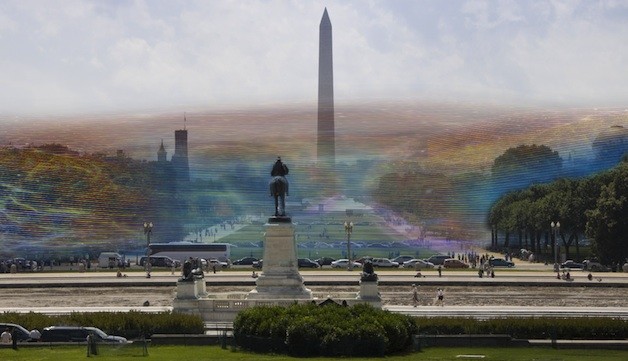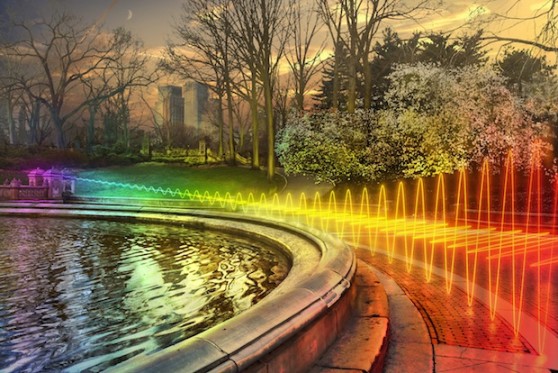Visualizing Wireless Data Flows
July 25, 2013
on
on

We heavily rely on the electromagnetic spectrum for our wireless data communications but few of us stop to realize we're permanently wading through a sea of signals. To show what the world would look like if we could actually perceive some of these signals, Artist Nickolay Lamm from MyDeals.com visualized Wi-Fi signals in a series of beautiful images.
Talking about what motivated him to create these images Lamm said: 'I feel a lot of us take technology for granted and use it without appreciating the science that makes it work.' To get the science right he worked together with M. Browning Vogel, an astrobiologist who worked at NASA Ames for five years and now teaches science at the University level. She provided captions for each image explaining how Wi-Fi works.
 Wifi is an energy field that is transmitted as waves. The waves have a certain height, distance between them and travel at a certain speed. The distance between wifi waves is shorter than that of radio waves and longer than that of microwaves, giving wifi a unique transmission band that can't be interrupted by other signals. Wifi waves are about 3 to 5 inches from crest to crest. The crests of waves is translated to a 1 by a computer, and the the troughs equal a 0. Chains of 1s and 0s that can be translated into the letters, numbers and codes that make up websites, email and other internet content. Typical wifi waves decrease in amplitude as they travel further from the source which is why the waves are larger to the right and smaller to the left, assuming the source is somewhere near the right of the image. This image shows an idealized wifi data transmitted over a band that is divided into different sub-channels, which are shown in red, yellow, green and other colors. Go see more images and Wi-Fi knowledge on Lamms page on MyDeals.com.
Wifi is an energy field that is transmitted as waves. The waves have a certain height, distance between them and travel at a certain speed. The distance between wifi waves is shorter than that of radio waves and longer than that of microwaves, giving wifi a unique transmission band that can't be interrupted by other signals. Wifi waves are about 3 to 5 inches from crest to crest. The crests of waves is translated to a 1 by a computer, and the the troughs equal a 0. Chains of 1s and 0s that can be translated into the letters, numbers and codes that make up websites, email and other internet content. Typical wifi waves decrease in amplitude as they travel further from the source which is why the waves are larger to the right and smaller to the left, assuming the source is somewhere near the right of the image. This image shows an idealized wifi data transmitted over a band that is divided into different sub-channels, which are shown in red, yellow, green and other colors. Go see more images and Wi-Fi knowledge on Lamms page on MyDeals.com.
Lamm created an entire series of What Would X Look Like including What Would Sea Level Rise Look Like on the West Coast? [of the US] and New York City on Different Planets. In each case he based his visuals on scientific data.
Talking about what motivated him to create these images Lamm said: 'I feel a lot of us take technology for granted and use it without appreciating the science that makes it work.' To get the science right he worked together with M. Browning Vogel, an astrobiologist who worked at NASA Ames for five years and now teaches science at the University level. She provided captions for each image explaining how Wi-Fi works.

Lamm created an entire series of What Would X Look Like including What Would Sea Level Rise Look Like on the West Coast? [of the US] and New York City on Different Planets. In each case he based his visuals on scientific data.
Read full article
Hide full article


Discussion (0 comments)